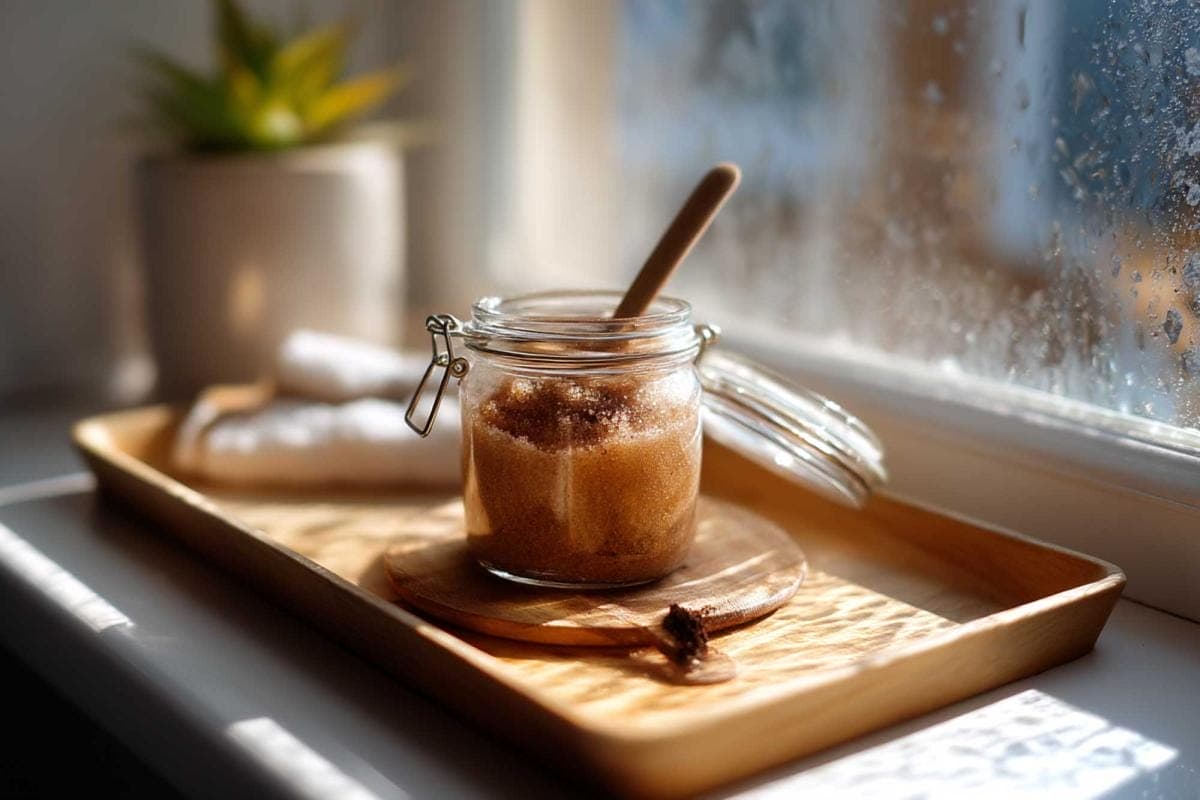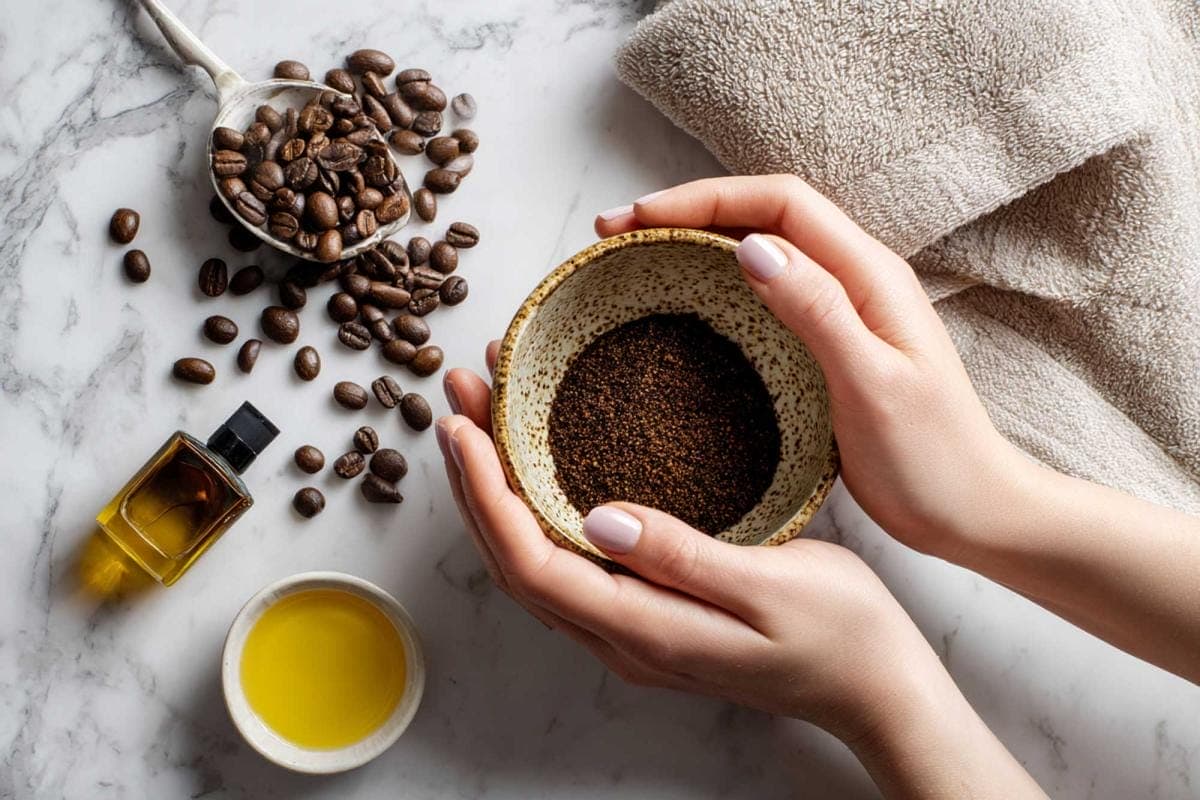If you click on links we provide, we may receive compensation.
Your skin works harder than you might think. It sheds about 30,000 dead cells every minute, yet it keeps guarding you from heat, cold, bumps, and bacteria every hour of the day. Those discarded cells build up when life gets busy, and that buildup can dull the glow that healthy skin naturally shows. Grocery-store aisles can help, but your kitchen pantry is already stocked with ingredients that polish, soften, and brighten. Over the years I have borrowed, tested, and tweaked many recipes, and a handful keep outperforming the rest. Today I am sharing the best of them – all easy to mix, budget-friendly, and deliciously scented.
When I first learned that sugar crystals could rival pricey spa scrubs, I scooped brown sugar straight from a baking canister and mixed it with olive oil. The result felt silky and smelled like cookies, yet the grains melted too quickly, and the finish was greasy. That afternoon taught me a lesson I still use: the right ratios make the magic. A balanced scrub stays grainy long enough to lift dead cells, yet it rinses clean, so no towel picks up residue. Think of each recipe below as a reliable blueprint. Once you see how your skin responds, you can play with scents, swap carrier oils, and even add herbs from the garden.
Smooth skin is not only about looks. Proper exfoliation lets moisturizers sink in instead of sitting on the surface. It encourages fresher cells to rise sooner, which helps rough patches fade. Dermatologists often remind patients that consistent, gentle abrasion stimulates micro-circulation, sending oxygen-rich blood closer to the epidermis. That extra circulation brings nutrients that feed collagen and keep skin springy. In my experience, a weekly scrub can even reduce the tiny red bumps that collect on the backs of arms in cooler months.
The Glow Equation: Grain Plus Binder
All great body scrubs rely on texture. You need a particle that buffs without scratching, paired with a binder that spreads easily. In the sugar-and-salt family, particle size matters more than brand. Fine sea salt feels smoother than coarse Himalayan, and raw turbinado sugar stays firm longer than powdered white. Coffee grounds, finely milled oats, and ground rice widen the toolbox. For binders, plant oils dominate. Sunflower, jojoba, grapeseed, almond, and coconut each bring distinct viscosity and vitamin content. Honey, aloe gel, and plain yogurt supply hydration and mild enzymes that dissolve clingy cells. When recipes blend mechanical rubbing with natural chemical exfoliants, the result amplifies brightening.
Selecting the Right Grain for Your Skin
Very dry or sensitive types often fare best with brown sugar because its edges soften quickly on wet skin. Normal-to-oily bodies welcome salt’s sharper profile, which can soak up excess sebum around pores. Coffee grounds land in the middle; their rounded shape buffers yet stays sturdy long enough to stimulate circulation. Rice flour, ground just fine enough, is beloved across Asia for its gentle touch and subtle brightening molecules like ferulic acid. Oat flour has another superpower: beta-glucans soothe itch and redness, making it the ideal partner during winter. Your choice can even change with the seasons. I reach for sugar in February but switch to salt once humidity returns in July.
Classic Brown Sugar Vanilla Polish
Close your eyes and imagine a warm bakery. That scent comes alive when brown sugar meets vanilla. Mix one cup of packed light brown sugar with half a cup of sunflower oil, then drizzle in a teaspoon of pure vanilla extract. Stir until the sugar glistens but no oil pools on top. Scoop a palmful into the shower and massage each limb in slow circles from ankle to hip and wrist toward shoulder. The sugar loosens as it melts, leaving only a whisper of oil that rinses easily. Sunflower’s high linoleic acid supports the skin barrier, a bonus if you shave right afterward. I like to whip a double batch and store it in a glass jar; it keeps for two weeks at room temperature.
Sea Salt Citrus Zest Revival
Salt carries the essence of oceans, so it pairs naturally with citrus. Grate the zest from one unwaxed lemon and one orange, avoiding bitter white pith. Combine the zest with two tablespoons of finely chopped fresh mint, then add one cup of fine sea salt. Pour in half a cup of grapeseed oil, known for its quick absorption, and stir well. The mint releases a cool burst, and the citrus oils brighten both mood and skin tone. This scrub feels invigorating after a workout when sweat and sunscreen need a deep cleanse. Because salt can sting freshly shaved skin or micro-cuts, I use light pressure and rinse sooner than with sugar. Pat dry, and you will notice the subtle sparkle of clean, polished arms.
Coffee Coconut Energizer
I drink coffee every morning, yet the grounds that remain still have work to do. Spent coffee retains caffeine, antioxidants, and a texture perfect for thighs and calves. Collect half a cup of dried, cooled grounds, then blend with half a cup of granulated sugar to keep the mix airy. Add three tablespoons of melted, but not hot, unrefined coconut oil and two teaspoons of cocoa powder. The final paste smells like a mocha latte. Massage it onto damp skin, focusing on areas prone to dimpling. Caffeine’s temporary vasoconstriction helps skin look smoother, while coconut oil’s lauric acid locks in moisture. Rinse with lukewarm water; the shower floor may darken but a quick wipe clears residue.
Rice Rose Gentle Brightener
Asian bridal traditions often include a rice powder scrub the night before the ceremony. The recipe I favor blends half a cup of superfine rice flour with one tablespoon of powdered milk, two tablespoons of raw honey, and enough rose water to create a thick paste. Honey supplies natural alpha hydroxy acids, while milk adds lactic acid for extra softening. Rice powder’s tiny particles lift pigmentation gently over time. Smooth the mixture over damp skin and let it rest for three minutes before rinsing. A faint floral scent lingers, and the skin feels silkier than before. People dealing with keratosis pilaris often report calmer bumps after regular use.

Oat Lavender Soothing Buff
Not every scrub aims for high shine; sometimes comfort is the priority. Finely ground oats excel at calming itchy or inflamed patches. Blend a cup of oat flour with three-quarters of a cup of aloe vera gel, then drizzle in a tablespoon of sweet almond oil and four drops of lavender essential oil. The gel lightens the mixture, preventing a heavy film on sensitive skin, while lavender’s linalool eases tension. Spread the cool cream over damp arms and legs, wait a minute, and rinse. The oats swell slightly, creating a milky rinse water that nourishes the skin barrier. I reach for this formula when winter air turns heating vents into desert winds.
Raw Sugar Pineapple Enzyme Glow
Some fruits carry enzymes that nibble away at dead cells without any scrubbing at all. Pineapple, rich in bromelain, ranks high on that list. Puree half a cup of fresh pineapple chunks, strain out the juicier pulp, and combine with half a cup of raw cane sugar plus two tablespoons of jojoba oil. The sugar grants grip while the enzyme softens glue-like bonds between older cells. Work the slush over elbows, knees, and heels. Leave the layer in place for two minutes before rinsing. Bromelain’s gentle chemical action complements the mechanical buff for maximum radiance. Avoid this scrub on freshly shaved skin; fruit acids can tingle.
Balancing Safety and Shelf Life
Homemade scrubs lack commercial preservatives, so they need mindful storage. Always spoon product out with clean, dry hands or a scoop. If water leaks into the jar, bacteria and mold can thrive. High-oil scrubs stay stable about four weeks when kept cool and out of direct sunlight. Formulas heavy in fresh fruit or yogurt last only a week in the refrigerator. Making smaller batches reduces waste and ensures potency. Essential oils add aroma but also carry antimicrobial traits that extend shelf life slightly. Tea tree, rosemary, and citrus oils inhibit microbial growth, though they are not replacements for proper hygiene.
Why Exfoliation Frequency Should Match Skin Needs
Exfoliating too often can backfire, stripping protective lipids and provoking micro-tears. Most dermatologists recommend body scrubs once or twice per week, with frequency adjusted by skin type, climate, and activity level. Heat, sweat, and sunscreen can demand a second weekly session in summer, whereas dry winter air might warrant only one gentle polish. Look for clues: if skin feels tight, stings under hot water, or shows flaky red patches, take a longer break. Hydrate thoroughly after every session. A body oil on damp skin seals moisture and maintains that fresh glow.
Layering Scrubs with Other Treatments
Body scrubs play nicely with masks and lotions, following the principle of thin to thick. After rinsing, pat dry and apply a lightweight hydrating gel or serum rich in humectants like glycerin. Once absorbed, layer a nourishing cream or oil. On days when you plan to self-tan, exfoliate first so color adheres evenly. If you use retinoid lotions on arms or legs, schedule them on nights you do not scrub, giving skin a rest between active treatments. Sunscreen remains non-negotiable. Fresh skin is more vulnerable to UV rays, so coat exposed limbs with broad-spectrum protection the next morning.

Environment and Ingredient Ethics
Kitchen scrubs dodge plastic microbeads that linger in oceans. Yet sourcing remains important. Choose fair-trade sugar and coffee when possible and reach for unrefined organic oils to minimize pesticide residue. Many home cooks already keep these staples on hand for baking. Empty food-grade glass jars make perfect containers; they wash easily and look attractive on a bathroom shelf. You can even upcycle petite jam jars for travel sizes or gifting. Adding handwritten labels turns each batch into a thoughtful present that introduces friends to sustainable self-care.
Listening to Your Skin’s Feedback
Just as hair differs wildly, skin reacts in its own language of smoothness, redness, or softness after a scrub. Note how long a post-scrub glow lasts. If radiance fades by evening, adjust ratios: increase oils or try a grain with prolonged melt time. Should small red dots appear, lighten pressure and choose a finer particle. Over the years I realized that coffee grounds excel on my legs yet feel too coarse on the delicate chest area. Paying attention transforms each practice from routine into dialog.
Frequently Asked Questions
How long should I massage a scrub before rinsing?
Gentle circles for about sixty seconds per body section are usually enough. Longer friction can irritate the skin’s barrier, so let the binder ingredients do extra work.
Can I use these recipes on my face?
Body skin is thicker than facial skin. Some people tolerate sugar on cheeks, but salt or coffee can scratch. For safety, reserve these blends below the neck and create a separate finer-grained formula for the face.
Why does my sugar scrub feel runny after a week?
Sugar absorbs moisture from the air and dissolves over time. Seal jars tightly and consider storing them in a cool cabinet rather than the humid shower ledge.
May I swap oils if I have a nut allergy?
Absolutely. Grapeseed and sunflower oils are both nut-free yet light in texture. Always patch-test a small area first to rule out sensitivity to any new ingredient.
Is it safe during pregnancy?
Most culinary ingredients pose little risk, but essential oils need caution. Many experts advise avoiding high concentrations of certain oils like rosemary or clary sage. Use simple unscented variants or consult a healthcare provider for guidance.




